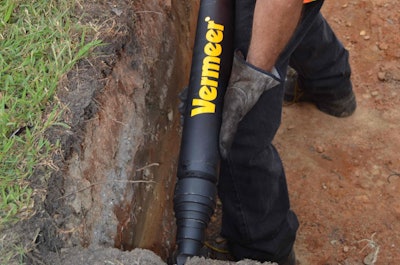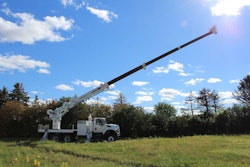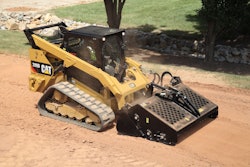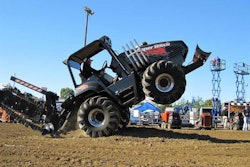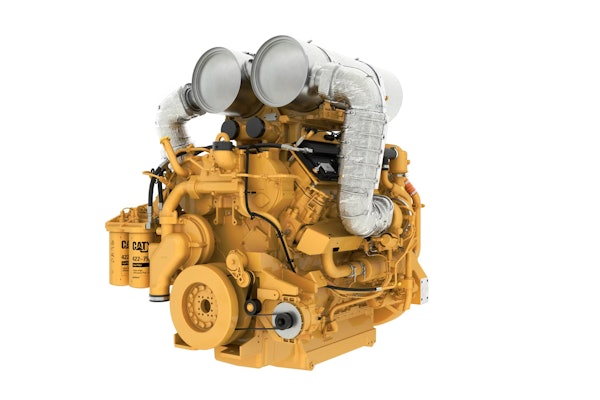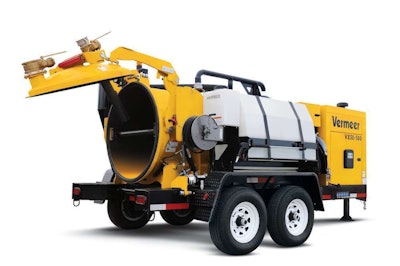 High ground clearance and a low center of gravity help McLaughlin’s second generation of vacuum excavation trucks negotiate tough terrain.
High ground clearance and a low center of gravity help McLaughlin’s second generation of vacuum excavation trucks negotiate tough terrain.With an eye towards greater efficiency and the rigors of the jobsite, including Texas oil fields, McLaughlin last week showed ICUEE attendees its second generation of vacuum trucks.
The VX50-500 vacuum truck sits on a robust, 8-inch, C-channel frame with 11-inches of ground clearance to pass over obstacles on the kind of rough roads and worksites typically found in the new oil patch. McLaughlin also mounted the control panel for these trucks up high to keep it clear of mud and debris. The trucks maintain a low profile, less than six feet high, to allow access to areas with height restrictions. This also lowers the center of gravity for better towing safety on the road.
A cam-over rear door design closes hydraulically, but locks mechanically so it can’t leak or open in the event of a hydraulic failure, or under reverse pressure. The door compresses a hefty D-ring set in a channel for a watertight seal. The door was also engineered to open to 80 degrees, rather than 45 degrees, for better access and dumping. Inside the tank, three water jets can be activated to wash down the walls and blast off any sticky or residual material.
A reverse pressure system will dislodge any rocks or large obstacles that get stuck in the vacuum wand. And an air-gap/quick-fill water tank lets you load up water as fast as possible. This second generation of vacuums offer a three-stage filtration system that allows for wet or dry vacuum excavation.
Mega Vac
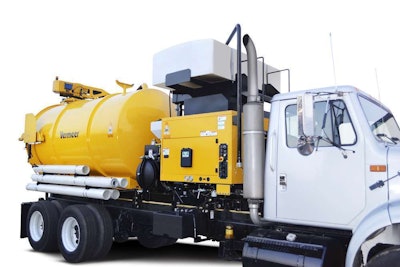 The Mega Vac eliminates the time wasting chore of having to make multiple trips to dump spoil.
The Mega Vac eliminates the time wasting chore of having to make multiple trips to dump spoil.Nobody wants their working machines to spend hours on the road, so McLaughlin also introduced a new large capacity vacuum excavator line matched to the capacities of mid-sized HDD machines. The Mega Vac series have tanks that can hold from 1,600 to 3,000 gallons, allowing contractors to remain on site all day rather than leave to dump the spoils. The Mega Vac also offers the option of a 1,025 or 1,200 cfm blower at 15 or 23 inches of mercury with standard or reverse flow for pressure offloading of materials.
A pressurized tank on the Mega Vac quickly forces fluid through the 6-inch gate valve on the rear of the unit, unloading as much as 2,600 gallons of spoil in about eight minutes. If you need it, a discharge hose can be connected to the rear outlet to guide spoils to a reclamation tank or retaining area.
Mini Core
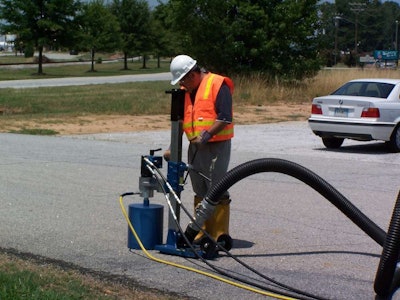 The Mini Core Drill, opens up holes in pavement and runs off the vacuum excavator’s hydraulic power.
The Mini Core Drill, opens up holes in pavement and runs off the vacuum excavator’s hydraulic power.Not even Superman can pothole through pavement, but the McLaughlin Mini Core Drill attachment works with the company’s 500, 800 and 1,200 gallon vacuum excavators to cut 6-, 8-, and 10-inch diameter holes in concrete or asphalt. After the core is removed the vacuum excavation can proceed. When finished, the operator backfills the hole and grouts the core back into place leaving the road surface with minimum disturbance. A vacuum suction base enables you to set up the Mini Core Drill quickly without having to drill bolt holes and pin the rig in place. The hydraulic pump on the excavator powers the unit.
Hole Hammer
